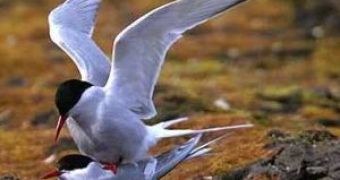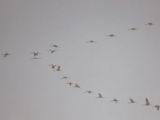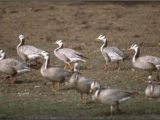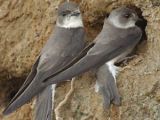65 % of the bird species migrate. The ancients, like Aristotle for example, thought that during the winter birds go inside the mud of the bottom of the swamps or in caves, where they pass the winter, and reemerge in the spring. In the 13th century, the German emperor Frederick the Second, passionate hunter, was the first to suppose they effectuate journeys to the warmer southern lands during the winter.
Some species make very short displacements during winter. For example, the Finnish rooks spend the winter in Northern Germany, displacing themselves with just 50 km (30 mi) daily. These birds are not real migrants, but vagrants. Migration is an instinct that even captive birds can not escape.
It is believed that geographic and clime changes during the Tertiary and Quaternary led to the development of the migration behavior. But migrations do not characterize just birds in temperate and cold areas, but also in the tropics.
Changes in the environment (like shorter days) trigger endocrine reactions, influencing the hypophyse. Offspring of migratory birds grown in captivity manifest a strange behavior during the migration periods: they refuse food and are restless during the time their species is on the way to the wintering places.
Birds do not migrate because of the cold, as you might think, but because they do not find food in winter. Those that can are sedentary. Many species of migratory birds accumulate fat before the journey. The journey is so instinctual that even warm autumns will not stop the birds' journey. Some species are forced to migrate due to the lack of food (like warblers) or by the snow and ice (like many duck species).
Nor do cold springs for their return, when many birds perish in cold waves.
The way birds migrate varies a lot: some will do it alone (like the cuckoo), others in pairs, while others in large flocks. In chaffinch (Fringilla coelebs), the males are sedentary while the females migrate.
Some birds migrate in well defined formations, the individual from the front of the line "splitting" the air and after a while passing in the rear for rest of the journey.
The little song birds usually form swarms.
The longest migration made by any bird is that effectuated by the Arctic tern (Sterna paradisaea), which nests on the Arctic zone, in the tundra region, and winters in the Antarctica (when there is the Austral summer). This 19,000 km (12,000 mi) journey ensures that this bird sees two summers per year and more daylight than any other creature on the planet.
One individual ringed on the Farne Islands, Northumberland, UK, in the summer of 1982 was found three months later, in October 1982 in Melbourne, Australia. The bird has made a sea journey of over 22,000 km (14,000 mi).
The American golden plover (Pluvialis dominica) nests in Alaska and winters in the Argentinean pampas, thus making a journey of 16,000 km (10,000 mi).
But even common birds in the temperate zones effectuate large migrations.
The barn swallow (Hirundo rustica) flies from Europe to South Africa about 8-10,000 km (5-6,000 mi) and the common cuckoo (Cuculus canorus) migrates till south Africa or Australia some 7,000 km (4,000 mi). Birds orientate during the migration using the position of sun, stars and Earth's electromagnetism.
Birds usually fly at 30-88 km (18- 52 mi)/h during the migration, making from 250 km (150 mi) to over 500 km (300 mi) daily.
But there are some exceptions. The northern lapwing (Vanellus vanellus) can fly continuously at 150 km/h (90 mi/h), crossing the Atlantic in 24 h.
Some gulls and sand martins can reach during the migration 200 km/h (125 mi/h) under favorable wind. This is amazing for sand martins (Riparia riparia), small birds, as they only use active flight (peregrine falcons can reach 390 km or 242 mi/h, but in dive). The spring migration is faster than the autumn migration, and adults migrate more rapidly than the young birds.
Over the sea, birds fly at hundreds of meters, using sea currents. That's why the heart in case of these little birds counts for 10 % of their weight! But the small song birds also get tired often and need rest, that's why they avoid deserts, oceans or mountains during their migration.
Larger birds do not get tired easily, and the record of the highest migratory flight is detained by cranes and geese.
In 1931 a bar headed geese (Anser indicus) flock was photographed at an altitude of 9,500 m (29,000 ft) over the Himalayas.
Some birds migrate during the daylight, like herons, storks, birds of prey, while others, like owls, cuckoo, woodcocks migrate during the night. Birds of prey and storks use thermal currents formed over the warm ground in their migratory flight.
As these currents form only during the daylight, they are forced to migrate only during this period and cannot cross large sea surface. That's why birds using thermal currents during migrations and others that cannot cross seas use specific corridors for crossing seas, concentrating there during their migration, like Gibraltar, Bosporus and Falsterbo (southern Sweden). Water birds prefer shores. Geese, ducks and cranes migrate both during the day and night.
Birds that eat grains or other vegetable items, eat during their migratory halts, but those that eat animal stuff (like pelicans, insectivorous, birds of prey, storks) usually do not, which means they accumulate fat before the great journey. They usually lose 25 % of their weight during the migration.
Researchers found that - besides their sight - birds also use the Earth's electromagnetism to navigate during their migration. This is how we can explained their ability to maintain their course over large distances, on no matter what weather.
Still, from place to place, the lines of the magnetic field vary and they do not always point the real north. The birds still do not deviate from their route because they adjust their "compass" with precision depending on the place where the Sun sets every evening. This is not influenced by latitude or season.
A petrel transported by plane from England to US turned back to its capture place in 12 days, after crossing 6,000 km (3,800 mi) over the ocean. The Pacific golden plover (Pluvialis fulva) flies tens of hours over the monotonous waters of the Pacific, from Alaska to Hawaii.
The slightest navigational error would mean death in the ocean's waves. But the birds always reach the right place, without any land mark. And even birds migrating over the land fly many times at 4-5,000 m over the ground, too high to use the landscape for orientation.
Even stranger, there are birds that do not migrate by flight but by walking! Crakes (Crex crex) travel their way almost exclusively on foot, flying only when they have to cross waters. Quails (Coturnix coturnix) mix aerial and terrestrial "paths": they can walk tens of kilometers during their migration.

 14 DAY TRIAL //
14 DAY TRIAL // 


